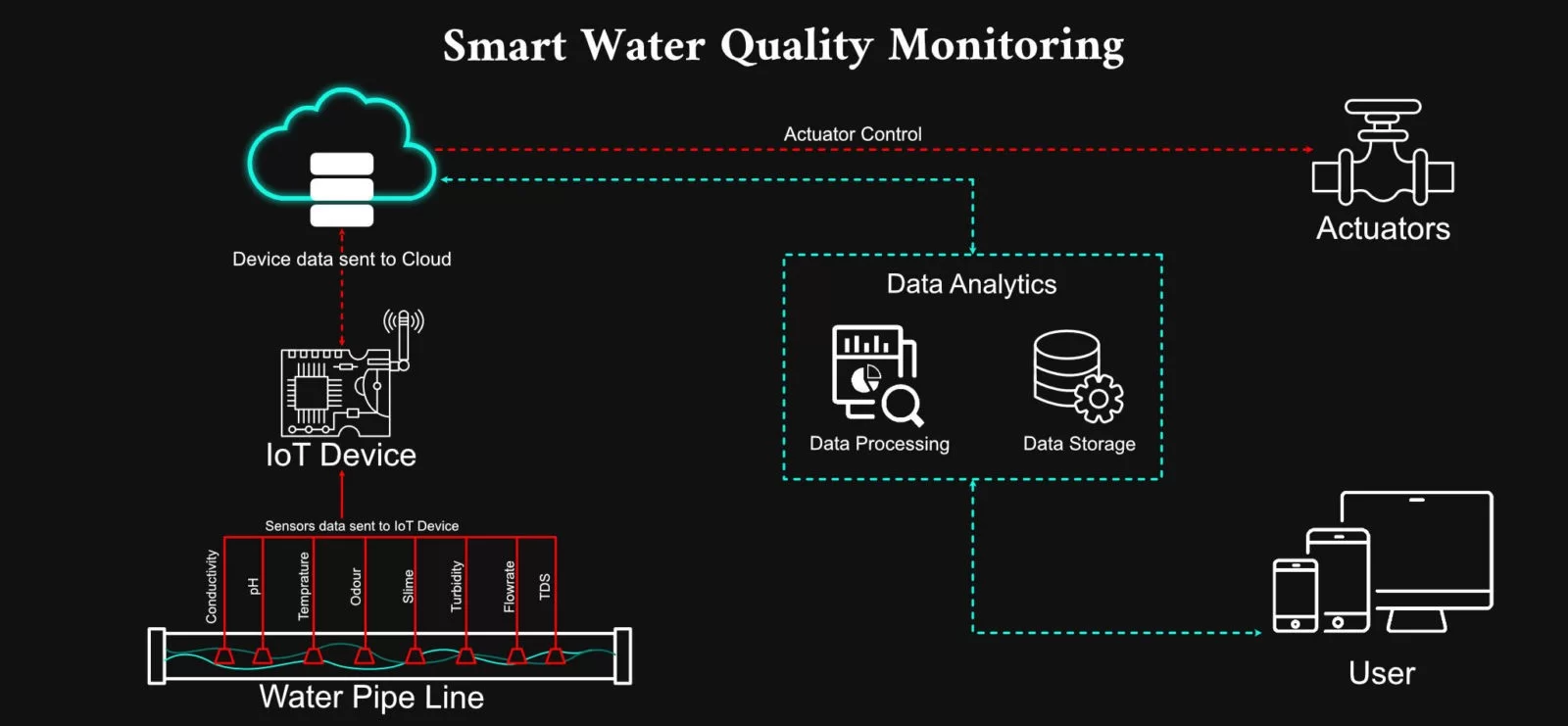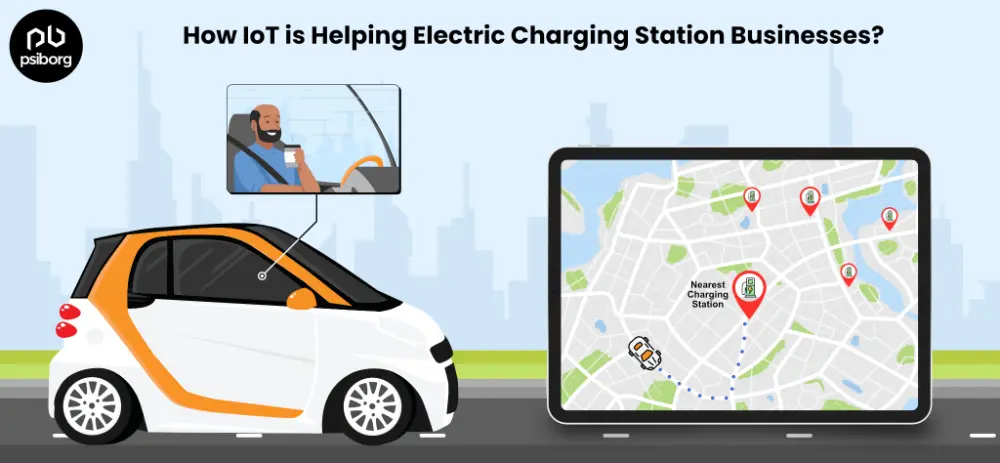Water is a scarce natural resource, and due to increasing urbanization and climate change, there is a need to have a smart water quality monitoring system in place. Water gets polluted at various points and from nonpoint sources. In order to identify these sources, we need a smart system that uses modern technologies like WSN (wireless sensor network), power of the cloud, integration with IoT (Internet of Things), and Big Data Analytics to get Real-time data on Water Quality so that we get better data and control over the water quality. Let’s read about the water quality control system.

WHAT IS A SMART WATER QUALITY MONITORING SYSTEM?
An IoT-based smart water quality monitoring system uses smart water quality sensor technology to measure water parameters such as temperature, dissolved oxygen levels, presence of suspended solids, TDS level, pH, turbidity, and more.
The primary objective of a smart water quality monitoring system is to make sure that these parameters are within a suitable range in the water.
The IoT-based water quality measurement system employs smart water quality sensors to keep track of the water parameters in real-time and gives valuable insights so that you can manage and monitor your water quality.
WHY YOU NEED SMART WATER MONITORING SYSTEM- FROM STATS POINT OF VIEW
If you are reading this section, then you agree that cloud-based water monitoring systems are vital for ensuring water quality across various domains to make sure the water you use is pure.
Groundwater is the drinking water source for approximately 75% of the population and is also used to irrigate crops.
According to the United States Environmental Protection Agency (EPA), after the COVID-19 pandemic, there is an increased threat of Legionella bacteria in the building’s plumbing system. These bacteria grow when the temperature decreases from the recommended 140 degrees Fahrenheit.
Moreover, tons of water are wasted every year due to meter errors, leakage, and other operational issues. And facility managers today rely on periodic manual inspections to identify failures. Thus, often a leak goes unnoticed until it catches the eye of the manager.
However, using a smart water monitoring system, you can detect how, where, and when water is getting leaked, giving you time to fix errors early. This way, it will save costs for the companies.
- Other than that, a smart water monitor is also necessary to:
- Characterize water and identify trends in water quality over time.
- Identify any emerging water quality problems
- Collect information for specific pollution prevention plans
- Respond to emergencies like spillages and floods.
HOW DOES THE SMART WATER QUALITY MONITORING SYSTEM WORK?
The power of Cloud, IoT, and Big Data Analytics, empowers electronic hardware-based embedded systems to get real-time data and monitoring insights over water quality.
Water quality sensors, as mentioned below, embedded with a controller unit, also known as a sensor node, send their data to the IoT Gateway or Edge gateway. It is an IoT device embedded with a microcontroller using the WSN (Wireless Sensor Network) protocol.
This data is then sent to a cloud server through the Internet. This Semi-Structured data is stored on the cloud server and trained on Machine Learning algorithms to produce real time information on water quality.
Actuator control systems are also connected through the cloud server, which reacts to the threshold value set by the user. Like whenever any water quality parameter (TDS, pH, temperature) changes in comparison to the threshold value. The set response like SMS, SOS, and control action will be triggered, and an alert will be sent to the user interface or associated application.
The information on the cloud can be analyzed and visualized on the user interface, which can be an IoT dashboard or a Mobile Application. Users can also carry out controlling actions based on the processed cloud server data.
Data Analysis of weekly/monthly/yearly stored data provides insights to get a good understanding of past data. This will enable better decision-making and planning of water resources for the future.
SENSORS USED IN WATER QUALITY MONITORING
Sensors are the eyes of the smart water pollution monitoring system. They are used to sense the Physical and Chemical properties of water. Various sensors are used in the Water pollution monitoring systems. Below are listed IoT sensors for water quality monitoring:
FLOW SENSORS:
These are devices used to measure or control the flow rate of liquid and gases within pipes or conduits. They are widely used in systems where controlled flow is required and where any leakage or pressure drop is to be detected in the piped water supply.
PH SENSOR:
It measures the Acidity / Basicity of water on a scale of 0 to 14. The ideal pH for drinking water should range between 6.5 to 8.5. pH controls microbial activity, fungal growth, and corrosion in piped systems.
TDS (TOTAL DISSOLVED SOLIDS):
Technically speaking, it is the amount of total dissolved minerals, metals, and salts dissolved in water. Measured in mg/L. It is the prime measure of drinking water quality.
CONDUCTIVITY SENSOR:
It measures the ionic concentration of metals and non-metals in an aqueous water solution. TDS and Conductivity sensors are most important for water quality monitoring in the agriculture sector for irrigation purposes.
TURBIDITY SENSOR:
It is an optical characteristic of water, which measures the relative clarity of the water. It is the measure of the amount of light that is scattered by materials in water. Useful in the river cleaning system and waste-water recycling.
TEMPERATURE SENSOR:
Water quality and activity change as the temperature changes. Hot water can dissolve more organic matter than cold water.
CHLORINE SENSOR:
water treatment plant adds chlorine to the water to kill possible microorganisms. At times, their concentration increases/decreases in drinking water, which causes various health issues in humans. Also, chlorine is a reducing agent which can deteriorate water pipelines.
ODOR SENSOR:
Many times, we experience clean water but it doesn’t smell good. So, odor sensors may be helpful in the quality control of water.
Also Read: Air Quality Monitoring Using IoT
USE-CASES OF WATER QUALITY MONITORING SYSTEM
WATER BODY POLLUTION
According to the Government of India, MoDW&S, data about 10.06 crore population living in 12,577 habitations in different states and union territories are getting drinking water with excess fluoride. Ingestion of excess fluoride can cause fluorosis which affects the teeth and bones. Similarly, a report from UNDP states that 80% of wastewater goes into waterways without adequate treatment, like Ganga. Due to this not only Drinking water but the River ecosystem also gets affected. Chlorine residual sensors, Conductivity sensors, and TOC (Total Organic Carbon) sensors embedded with IoT hardware and software are the saviour in such a scenario.
PIPED WATER SUPPLY
Increasing urbanization puts pressure on scarce water resources and supplying piped water to every household requires a network of cast iron pipes. The water supply network consists of long water pipelines which are prone to leakage, due to various joints, which if go undetected, lead to water loss. Smart IoT-based sensors and solutions like smart flow controllers and smart water level monitoring system can be used to effectively monitor such leakages on a real-time basis.
CHEMICAL AND HVAC INDUSTRIES
These industries are one of the major sources of water pollution. Governments around the world have strict water discharge guidelines and are mandated to have ETP (Effluent Treatment Plant). Water high in chlorine, saline, and fluoride impurities causes fouling, and corrosion and puts pressure on the industry’s equipment. So to increase efficiency and save energy, a smart IoT-based waste-water monitoring system with big data analytics will give better insights.
AGRICULTURE SECTOR
IoT has huge potential to revolutionise the Agriculture sector, one such example could be a smart irrigation system that would control and monitor water quality.
Water used by farmers for irrigation purposes, calculated as the percentage of total water usage, is high. Most of this water is polluted and prone to overuse. Besides this, farmers over-irrigate their lands. If they use the IoT-based real-time river water quality monitoring systems and sensors listed above, they can effectively control and monitor water quality.
In addition to this, traditionally used water quality monitoring methods are manual and prone to human error. Also, it is cost-intensive because it requires a large number of point sources for sample collection and training costs for individuals. Plus, obviously, data quality issues are there since the data collected is not regular and it is not stored on a real-time basis. This produces a need for a Smart water quality monitoring system.
Nevertheless, we at PsiBorg, an IoT product development company, use state-of-the-art technology integration that provides complete IoT solutions for water quality monitoring issues on a case-to-case basis.
FAQ
An IoT-based smart water monitoring system generally consists of sensors, communication infrastructures, data processing and analysis, and a mobile or web app. All these components work together to provide smart monitoring of water.
IoT offers various benefits in anything related to monitoring and tracking. In the case of water pollution monitoring system, the use of IoT technology will help you automate your monitoring tasks, thus reducing the need for manual inspection. Also, with IoT-driven predictive maintenance, you can reduce the operation cost and minimize downtime, making water management more effective.
Yes, the IoT water monitoring system is compatible with various water sources, including wells, municipal supplies, and rainwater harvesting systems. IoT-based water monitoring systems can be customized with sensors and data collection methods. The aforementioned can be tailored to a specific water source, ensuring accurate monitoring and efficient management across diverse water supply systems.
A smart water monitoring system uses several sensors to detect water quality. However, the top 5 sensors used in water quality monitoring systems are- pH sensor, turbidity sensor, TDS sensor, chloride sensor, and temperature sensor.
The objective of a smart water quality monitoring system is to prevent any potential health hazards or threats from drinking water. Moreover, the solution is designed to obtain quantitative information on the physical, chemical, and biological characteristics of water.






